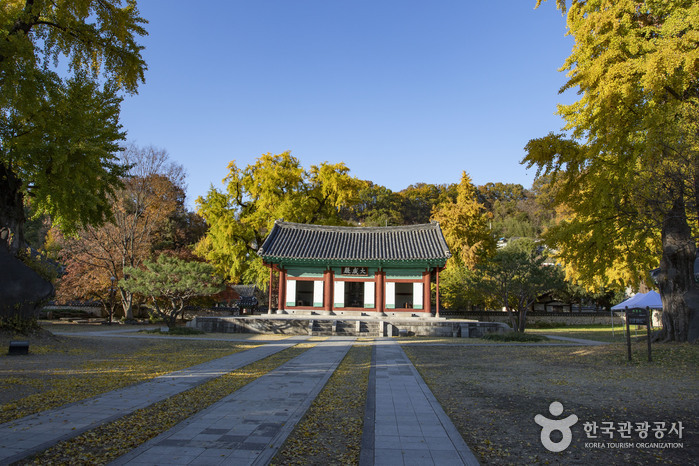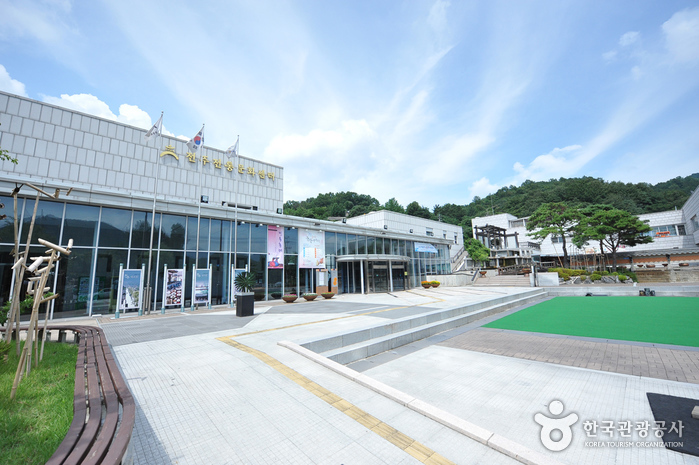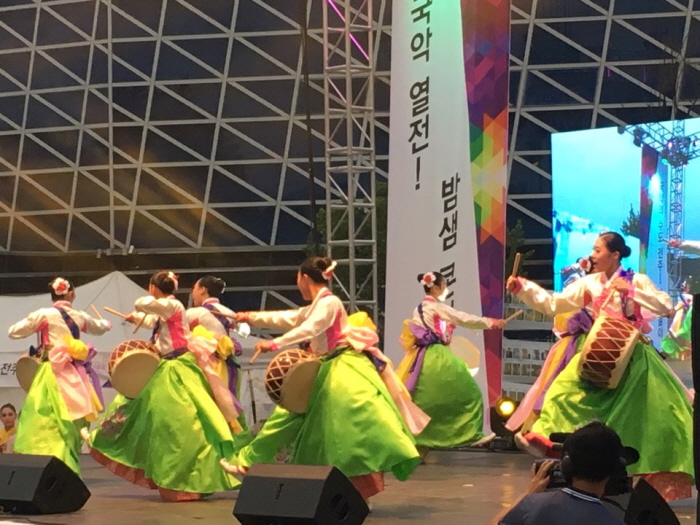Cathédrale Jeondong (전주전동성당)
684.3247411426316m 7513 2024-04-08
51, Taejo-ro, Wansan-gu, Jeonju-si, Région Jeonbuk
Cette cathédrale bâtie en 1914 dans un style occidental est classé trésor national numéro 288. Il s’agit de la plus grande structure des deux provinces du Jeollado. La large façade en briques rouge ainsi que l’entrée et le clocher sont assez impressionnants en hiver. La voûte d’entrée rappelle le style byzantin, tandis que le petit clocher situé au centre ajoute un charme particulier. Malheureusement une partie de la cathédrale fut détruite dans un incendie en 1988.
La cathédrale de Jeondong a été construite en honneur des catholiques martyrs durant la dynastie Joseon. Le terrain fut acheté par le moine français Baudenet en 1891 (28ème année de règne du roi Gojong). On doit l'architecture du site au prêtre Poinel qui est aussi à l'original de la cathédrale de Myeongdong à Seoul.
ONEWWAL[Korea Quality] / 오뉴월[한국관광 품질인증/Korea Quality]
701.8485610922788m 101 2024-04-07
51-5, Hyanggyo-gil, Wansan-gu, Jeonju-si, Région Jeonbuk
+82-10-3670-2581
Onyuwol is a “hanok” guesthouse located in Jeonju Hanok Village. It is attached to a café that combines hanok and modern interior design and has enjoyed considerable popularity via word-of-mouth among young travelers. There are five rooms in total, which are furnished comfortably like their namesakes (the months of May and June). The rooms bear the hallmark elegance of hanok, from their exposed rafters to red clay floors, white cotton beddings, and muslin curtains. The furnishings remained minimalist, with only bedding, a small TV, electric kettle, and a basket containing a towel, hairdryer, and a hand mirror. The sleep-themed room names show that they are furnished with a restful stay in mind. Opening the door brings guests to the view of the peaceful garden. Nabijam and Kkotjam rooms have small attics that add a layer of elegance, while only the Danjam room is furnished with a bed. All rooms are equipped with bathrooms. Guests can also enjoy a complimentary cup of Americano in the café, and international guests have access to English services. Furthermore, its location makes it a good starting point for visits to Jeonju’s major tourist sights, such as Jeonjuhyanggyo Local Confucian School, Gyeonggijeon Shrine, Omokdae Historical Site, or the alleyways of the historical city.
Hakindang [Korea Quality] / 학인당 [한국관광 품질인증]
710.4706203464434m 12809 2024-04-08
45, Hyanggyo-gil, Wansan-gu, Jeonju-si, Région Jeonbuk
+82-63-284-9929
Hagindang was built by the same master builder and carpenter who took part in building the palaces. It's the oldest traditional Korean house in Jeonju Hanok Village and a city/province-designated Folklore Heritage No. 8 situated in Hyanggyo-gil. It has a tall gate in the middle of high walls on either side, behind which are a large front yard with a pond as well as trees surrounding the pond. The house behind this pond is in perfect harmony with the landscape. Right next to the tall gate are a detached building called “sarangchae” and an area designated for experiencing Korean tradition, including another detached building called “byeoldangchae” behind the main building named “Hagindang.” Bonchaedaegwan, which consists of three rooms named “Baekbeomjisil,” “Haegongjisil,” and “Injaejisil” exude elegance and grace The “sarangchae” is a stand-alone building with two rooms with an open living room called "daecheong" in between, making it a perfect place for an entire family to stay. The "byeoldangchae" has a total of three rooms, and the first one (Room No. 1) has a tea room with three windows made of thin wooden frames on three sides. Hagindang serves traditional Korean breakfast like the head family.
Jeonju Hyanggyo (école confucéenne) (전주향교)
753.4190797845613m 6019 2024-04-08
139, Hyanggyo-gil, Wansan-gu, Jeonju-si, Région Jeonbuk
+82-63-288-4548
Fondée durant la dynastie Joseon (1392-1910), Jeonju Hyanggyo a été déclarée site historique n° 379. Signifiant « école provinciale », Hyanggyo était un établissement national d’éducation installé en province qui fournissait des enseignements confucianistes pendant la dernière dynastie coréenne. L’école confucéenne de Jeonju était située originairement aux alentours du lieu saint Geonggijeon, mais elle a été déplacée à son endroit actuel en 1603.
Elle abrite les plaques commémoratives de sept confucianistes chinois, y compris Confucius, et de dix-huit savants coréens dans le bâtiment principal appelé Daesungjeon. Composée de ce bâtiment et de seize autres, cette école figure parmi les plus grands établissements d’éducation de par sa taille.
Hanokhyeyum[Korea Quality] / 한옥혜윰[한국관광 품질인증/Korea Quality]
765.8081880417413m 103 2024-04-07
42-5, Hyanggyo-gil, Wansan-gu, Jeonju-si, Région Jeonbuk
+82-10-5512-1226
Located in Jeonju Hanok Village, Hanok Hyeyum offers a traditional “hanok” (traditional Korean house) experience to its guests. The Korean term “hyeyum” means “thought,” and the hostel’s name pertains to the owners’ wishes of providing new feelings and thoughts to visitors. Its design faithfully brings the feel of the grain on the timber, which was possible with the participation of Daemokjang and Somokjang artisans specializing in hanok construction. The hanging sign at the entrance is carved by a Mokjogakjang, an artisan carpenter and holder of Intangible Cultural Property, and the same spirit of dedication and passion can be found throughout the building. There are six rooms in total, all Korean-style with exposed rafters, handwritten calligraphy, dainty furniture, and masterful teacups. Guests can also find a surprise welcome package of face mask packs. All rooms have modern and sleek bathrooms, while some rooms come with small attic spaces. Hanok Hyeyum also offers pickup services to solo female travelers from the Jeonju Bus Terminal or Jeonju Station, and a complimentary breakfast with a seasonal menu, including items like rice cakes, egg, sweet potato, fruits, and coffee.
Musée de la calligraphie Gangam (강암서예관)
784.9168522254045m 3704 2024-04-07
74, Jeonjucheondong-ro, Wansan-gu, Jeonju-si, Région Jeonbuk
+82-63-285-7442
Inauguré en 1995, le musée Gang-am est un établissement spécialisé en calligraphie. Situé dans le village des hanok (maisons traditionnelles coréennes) de Jeonju, il expose environ mille œuvres de calligraphes illustres tel que Kim Jeong-Hui (1786-1856, peintre, calligraphe et savant), Lee Sam-Man (1770-1845, calligraphe), Kim Hong-Do (1745- ?, peintre), Jeong Yak-yong (1762-1836, savant), etc.. Le musée s’étend sur 872 ㎡, il comporte des salles d’expositions et des salles de conférences. Sa collection comprend 1.162 pièces.
Gyo Dong Sal Rae [Korea Quality] / 교동살래 [한국관광 품질인증]
786.6382221436768m 846 2024-04-07
66-1, Jeonjucheondong-ro, Wansan-gu, Jeonju-si, Région Jeonbuk
+82-10-9043-6743
Located at the entrance to Namcheongyo Bridge, which flows over Jeonjucheon Stream, Gyodongsalrae is a hanok structure built in 1971. It consists of the sarangchae (men’s quarters), anchae (women’s quarters), and byeolchae (detached House) and has ten guestrooms in total. While the sarangchae is situated near the road, the anchae and byeolchae are located to the rear of the house. Each building has a well-maintained flowerbed filled with seasonal flowers that harmonize perfectly with the beauty of the hanok.
The interior of the house is decorated with a variety of antiques, paintings, embroidery and knitting works, creating a cozy atmosphere. The ten rooms are of different sizes and styles including an ondol (Korean floor heating system) room, a room with a bed, and a darak (garret) room. The sarangchae consists of the Changpobang, Maehwabang, Baerongbang and Mokryeonbang rooms, of which the last two have a terrace with an open view. The anchae consists of a living room (sarangbang) and a room for two people. The byeolchae with a small courtyard has three large rooms with a capacity of four to six people and a separate space for relaxation and breakfast.
Hanok Garden in Jeonju [Korea Quality] / 전주한옥마당 [한국관광 품질인증]
787.0492583036754m 249 2024-04-07
80-13, Jeonjucheondong-ro, Wansan-gu, Jeonju-si, Région Jeonbuk
+82-10-9494-4579
Jeonju Hanok Madang is located in the Jeonju Hanok Village. Jeonjucheon Stream and Namcheongyo Bridge are only one block away, whereas Gangam Calligraphy Museum, Jeonjuhyangyo Confucian School, Jeonju Hanbyuk Culture Center, Nambu Market, and Markbu Market Youth Mall are nearby. Major attractions of the Jeonju Hanok Village such as Gyeonggijeon, Jeondong Catholic Cathdral, and Omokdae are also within walking distance.
The main building and servants’ quarters of Jeonju Hanok Madang were built in 1941. It was renovated to retain the original shape of the traditional hanok, yet cozy and comfortable enough for modern people to use. Porches are attached to every room while Faith Room and Hope Room have additional inner floors attached to it. Inside the rooms are rafters, beams, wooden pillars walled with Hanji wallpapers, and ribs of lattice doors. There is a clean bathroom in each room.
The yard is the place the owner couple cherishes the most. Guests can enjoy the yard in any room just by opening the door. It is a combination of jar stands, a small pine tree, and small potted plants. Different flowers bloom from spring through autumn. It is such a pleasure to sit on the porch and appreciate the scene. In autumn, the persimmon tree bears fruits and dried persimmons hang from the eaves.
Centre de la culture traditionnelle de Jeonju (전주전통문화관)
813.1096538388963m 2321 2023-04-06
20, Jeonjucheondong-ro, Wansan-gu, Jeonju-si, Région Jeonbuk
Le centre de la culture traditionnelle de Jeongju offre aux visiteurs un large panel sur les traditions, ainsi que la possibilité de voir des performances de chants « pansori » ou dances « minyo » traditionnels. Ceci, ouvert au public tout au long de l’année. Dans le hall des restaurants traditionnels il est possible de déguster divers spécialités tel que le bibimpap (riz avec des légumes) un des plats les plus réputés de Jeonju. Par ailleurs, un hall de mariages traditionnels accueillent les cérémonies de mariage.
Festival Daesaseup de Jeonju (전주대사습놀이전국대회)
845.525861282407m 925 2024-04-07
151-9, Jeonju MBC Hall, Junghwasandong 2-ga, Wansan-gu, Jeonju-si, Région Jeonbuk
- Ligne info Tourisme +82-63-1330 (coréen, anglais, japonais, chinois) - Pour obtenir plus d'info +82-63-252-6792 (coréen)
Daesaseup origine de la musique pansori qui est apparu à l'époque du règne du roi Yeongjo's (dynastie Joseon) et a été transmis jusqu'à aujourd'hui. Le Festival de Jeonju Daesaseup remonte à l'époque où les artistes en circulation de tout le pays ont été invités à un festival de la chanson toute la nuit à la veille du solstice d'hiver. Pour participer ce festival, les chanteurs doués de tout le pays se réunissent.

![ONEWWAL[Korea Quality] / 오뉴월[한국관광 품질인증/Korea Quality]](http://tong.visitkorea.or.kr/cms/resource/97/2651897_image2_1.jpg)



![Gyo Dong Sal Rae [Korea Quality] / 교동살래 [한국관광 품질인증]](http://tong.visitkorea.or.kr/cms/resource/71/2556371_image2_1.jpg)
![Hanok Garden in Jeonju [Korea Quality] / 전주한옥마당 [한국관광 품질인증]](http://tong.visitkorea.or.kr/cms/resource/43/2594443_image2_1.png)


 Français
Français
 한국어
한국어 English
English 日本語
日本語 中文(简体)
中文(简体) Deutsch
Deutsch Español
Español Русский
Русский